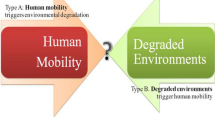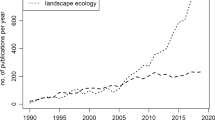Abstract
The increasing anthropogenic and technogenic impact on the soil and vegetation cover and water resources of Central Asia has sharply accelerated the degradation and desertification of natural pastures in this region, which was accompanied by a deterioration in the fodder base for animal husbandry, and, as a result, in the quality of life of the population. The theoretical substantiation of methods for economically profitable ecological restoration of lost biodiversity and forage productivity of desertified lands is an important scientific task. To solve it, the authors propose to use approaches based on biogeocenotic principles of the formation of multispecies multilevel pasture biogeocenoses, recreating optimal florocenotic structures by introducing zonal basic dominant species and life forms of forage plants into their composition. Such reconstructed biogeocenoses have the property of self-renewal and self-maintenance of the natural structural and functional organization. They are also of great nature conservation value because they contribute to the suspension of the desertification of arid pasture lands, the cessation of dust storms, and the restoration of optimal environmental parameters.






Similar content being viewed by others
REFERENCES
N. T. Nechaev and Z. Sh. Shamsutdinov, “Anthropogenic dynamics of desert biogeocenoses and ways to restore their productivity,” in Problems of Anthropogenic Dynamics of Biogeocenoses: Readings in Memory of Academician V.N. Sukachev, Ed. by I. A. Shilov (Nauka, Moscow, 1990), pp. 31–53 [in Russian].
Zh. A. Zhambakin, Pastures of Kazakhstan: Use Technology (Kainar, Almaty, 1995) [in Russian].
L. S. Gaevskaya, Karakul Pastures of Central Asia (FAN, Tashkent, 1971) [in Russian].
I. S. Zonn, G. S. Kust, N. S. Orlovskii, et al., “Desertification,” in Deserts and Desertification: Encyclodepia (Mezhdunar. Otn., Moscow, 2018), pp. 421–423 [in Russian].
M. J. Novacek and E. E. Cleland, “The current biodiversity extinction event: Scenarios for mitigation and recovery,” Proc. Natl. Acad. Sci. U. S. A. 98 (10), 5466–5470 (2001).
J. A. Harris, R. J. Hobbs, E. S. Higgs, and J. A. Aronson, “Ecological restoration and climate change,” Restor. Ecol. 14 (2), 170–176 (2006).
A. S. Kerzhentsev, Functional Ecology (Nauka, Moscow, 2006) [in Russian].
M. A. Palmer, J. B. Zedler, and D. A. Falk, “Ecological theory and restoration ecology,” in Foundations of Restoration Ecology, Ed. by D. A. Falk, M. A. Palmer, and J. B. Zedler (Island Press, Washington, 2016), pp. 3–26.
Resolution adopted by the General Assembly on March 1, 2019, 73/284. United Nations Decade on Ecosystem Restoration (2021–2030). https://undocs.org/en/A/RES/73/284.
The SER International Primer on Ecological Restoration. Society for Ecological Restoration. International Science & Policy Working Group (Version 2: October, 2004). https://www.ctahr.hawaii.edu/littonc/PDFs/682_SERPrimer.pdf.
W. Steffen, K. Richardson, J. Rockström, et al., “Planetary boundaries: Guiding human development on a changing planet,” Science 347 (6223), 736–747 (2015).
M. A. Palmer and J. B. Ruhl, “Aligning restoration science and law to sustain ecological infrastructure for the future,” Frontiers Ecol. Envir. 13 (9), 512–519 (2015).
K. N. Suding, E. Higgs, M. A. Palmer, et al., “Seeing the forest and the trees: Comprehensive ecological restoration,” Science 348 (6235), 638–640 (2015).
Fundamentals of Forest Biogeocenology, Ed. by V. N. Sukachev and N. V. Dylis (Nauka, Moscow, 1964) [in Russian].
T. A. Rabotnov, Phytocenology (Mosk. Gos. Univ., Moscow, 1983) [in Russian].
V. G. Onipchenko, Functional Phytocenology: Plant Synecology (Krasand, Moscow, 2013) [in Russian].
B. M. Mirkin and L. G. Naumova, Introduction to Modern Vegetation Science (GEOS, Moscow, 2017) [in Russian].
V. N. Sukachev, “Development idea in phytocenology,” Sov. Botanika, Nos. 1–3, 5–17 (1942).
G. M. Zozulin, “Scientific and practical aspects of using landscapes as standards of nature,” in Man and the Biosphere (Izd. Rostov. Univ., Rostov, 1977), pp. 158–167 [in Russian].
L. G. Ramenskiy, Selected Works: Problems and Methods of Study of the Plant Cover (Nauka, Leningrad, 1971) [in Russian].
J. P. Grime, Plants Strategies and Vegetation Processes (John Wiley & Sons, New York, 1979).
J. P. Grime, Plant Strategies, Vegetation Processes, and Ecosystem Properties, 2nd ed. (John Wiley & Sons, New York, 2001).
L. G. Ramenskiy, Introduction to Integrated Soil Geobotanical Research (Sel’khozgiz, Moscow1938.
E. P. Odum, Fundamentals of Ecology (Saunders, Philadelphia, 1953).
G. E. Hutchinson, “Concluding remarks,” Cold Spring Harbor Symp. Quant. Biol. 22, 415–427 (1957).
A. S. Severtsov, “Relation between fundamental and realized ecological niches,” Biol. Bull. Rev. 3 (3), 187–195 (2013).
B. A. Abaturov, “Competitive separation of herbaceous and woody plant communities in steppe and forest zones,” Usp. Sovr. Biol. 134 (5), 467–475 (2014).
K. A. Kurkin, “Meadow grass mixture design system,” Byull. Mosk. Obshch. Ispyt. Prir. Otd. Biol., No. 4, 3–14 (1983).
B. M. Mirkin, Theoretical Foundations of Modern Phytocenology (Nauka, Moscow, 1985) [in Russian].
V. S. Zaletaev, Desert Life: Geographic–Biogeocenotic and Ecological Problems (Mysl’, Moscow, 1976) [in Russian].
Funding
This study was supported by the Russian Science Foundation, project no. 19-16-00114.
Author information
Authors and Affiliations
Corresponding authors
Additional information
Translated by B. Alekseev
RAS Corresponding Member Zebri Shamsutdinovich Shamsutdinov is Chief Researcher at the Federal Williams Research Center of Forage Production & Agroecology. Nariman Zebrie-vich Shamsutdinov, Dr. Sci. (Biol.), is a RAS Professor and Chief Researcher at the All-Russia Kostyakov Research Institute for Hydraulic Engineering and Land Reclamation. Nikolai Sergeevich Orlovskii, Dr. Sci. (Geogr.), is a Professor at the Jacob Blaustein Institutes for Desert Research, Ben-Gurion University. El’mira Zebrievna Shamsutdinova, Cand. Sci. (Agric.), is a Leading Researcher and Head of the Laboratory of Arid Forage Plants at the Federal Williams Research Center of Forage Production & Agroecology.
Rights and permissions
About this article
Cite this article
Shamsutdinov, Z.S., Shamsutdinov, N.Z., Orlovskii, N.S. et al. Biogeocenotic Principles of Pasture Restoration in the Central Asian Desert. Her. Russ. Acad. Sci. 91, 204–212 (2021). https://doi.org/10.1134/S1019331621020076
Received:
Revised:
Accepted:
Published:
Issue Date:
DOI: https://doi.org/10.1134/S1019331621020076




